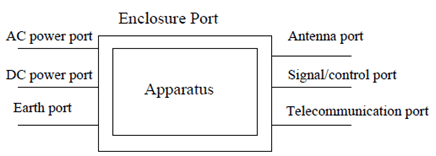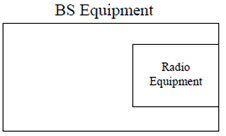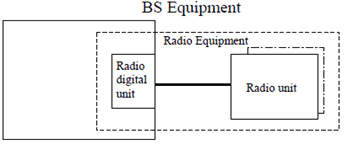Content for TS 25.113 Word version: 18.0.0
1 Scope
2 References
3 Definitions, symbols and abbreviations
3.1 Definitions
3.2 Symbols
3.3 Abbreviations
...
...
1 Scope p. 6
The present document covers the assessment of base stations, repeaters and associated ancillary equipment in respect of Electromagnetic Compatibility (EMC).
The present document specifies the applicable test conditions, performance assessment and performance criteria for base stations, repeaters and associated ancillary equipment in one of the following categories:
- base stations for the FDD mode of UTRA meeting the requirements of TS 25.104, with conformance demonstrated by compliance to TS 25.141.
- base stations for both options of the TDD mode of UTRA meeting the requirements of TS 25.105, with conformance demonstrated by compliance to TS 25.142. The two options are the 3,84 Mcps and 1,28 Mcps options respectively. The requirements are listed in different subsections only if the parameters deviate.
- repeaters for the FDD mode of UTRA meeting the requirements of TS 25.106, with conformance demonstrated by compliance to TS 25.143.
2 References p. 6
The following documents contain provisions which, through reference in this text, constitute provisions of the present document.
- References are either specific (identified by date of publication, edition number, version number, etc.) or non-specific.
- For a specific reference, subsequent revisions do not apply.
- For a non-specific reference, the latest version applies. In the case of a reference to a 3GPP document (including a GSM document), a non-specific reference implicitly refers to the latest version of that document in the same Release as the present document.
[1]
TS 25.104: "UTRA (BS) FDD; Radio transmission and reception".
[2]
TS 25.105: "UTRA (BS) TDD; Radio transmission and reception".
[3]
TS 25.141: "UTRA (BS) FDD; Base station conformance testing (FDD)".
[4]
TS 25.142: "UTRA (BS) TDD; Base station conformance testing (TDD)".
[5]
IEC 61000-6-1: 2005; "Electromagnetic compatibility (EMC) - Part 6: Generic standards - Section 1: Immunity for residential, commercial and light-industrial environments".
[6]
IEC 61000-6-3: 2006/AMD1:2010: "Electromagnetic compatibility (EMC) - Part 6: Generic standards - Section 3: Emission standard for residential, commercial and light industrial environments".
[7]
IEC 60050(161): "International Electrotechnical Vocabulary - Chapter 161: Electromagnetic compatibility".
[8]
TS 25.101: "UTRA (UE) FDD; UE Radio transmission and reception (FDD)".
[9]
TS 25.102: "UTRA (UE) TDD: UE Radio transmission and reception (TDD)".
[10]
TS 25.106: "UTRA Repeater; Radio Transmission and Reception".
[11]
TS 25.143: "UTRA Repeater conformance testing".
[12]
ITU-R Rec. SM.329: "Unwanted emissions in the spurious domain".
[13] Void
[14]
CISPR 16-1-1: "Specification for radio disturbance and immunity measuring apparatus and methods - Measuring apparatus".
[15]
IEC 61000-3-2 (2004): "Electromagnetic compatibility (EMC) - Part 3: Limits - Section 2: Limits for harmonic current emissions (equipment input current ≤ 16 A)".
[16]
IEC 61000-3-3 (2002): "Electromagnetic compatibility (EMC) - Part 3: Limits - Section 3: Limitation of voltage fluctuations and flicker in low-voltage supply systems for equipment with rated current ≤ 16 A".
[17]
IEC 61000-4-2: "Electromagnetic compatibility (EMC) - Part 4: Testing and measurement techniques - Section 2: Electrostatic discharge immunity test".
[18]
IEC 61000-4-3: "Electromagnetic compatibility (EMC) - Part 4: Testing and measurement techniques - Section 3: Radiated, radio-frequency electromagnetic field immunity test".
[19]
IEC 61000-4-4: "Electromagnetic compatibility (EMC) - Part 4: Testing and measurement techniques - Section 4: Electrical fast transient/burst immunity test".
[20]
IEC 61000-4-5: "Electromagnetic compatibility (EMC) - Part 4: Testing and measurement techniques - Section 5: Surge immunity test".
[21]
IEC 61000-4-6: "Electromagnetic compatibility (EMC) - Part 4: Testing and measurement techniques - Section 6: Immunity to contacted disturbances, induced by radio frequency fields".
[22]
IEC 61000-4-11: "Electromagnetic compatibility (EMC) - Part 4: Testing and measurement techniques - Section 11: Voltage dips, short interruptions and voltage variations. Immunity tests".
[23]
ITU-R Recommendation SM.1539 (2001): "Variation of the boundary between the out-of-band and spurious domains required for the application of Recommendations ITU-R SM.1541 and ITU-R SM.329".
[24]
TR 21.905: "Vocabulary for 3GPP Specifications".
[25]
IEC 61000-3-12 (2005): "Electromagnetic compatibility (EMC) - Part 3-12: Limits- Limits for harmonic current produced by equipment connected to public low-voltage system with input current >16 A and ≤ 75 A.
[26]
IEC 61000-3-11 (2000): "Electromagnetic compatibility (EMC) - Part 3-11: Limits -Limitation of voltage fluctuations and flicker in low-voltage supply systems for equipment with rated current ≤ 75 A and subject to conditional connections"3 Definitions, symbols and abbreviations
[27]
TS 37.113: "E-UTRA, UTRA and GSM/EDGE; Multi-Standard Radio (MSR) Base Station (BS) Electromagnetic Compatibility (EMC)".
[28]
CISPR 32: "Electromagnetic compatibility of multimedia equipment - Emission requirements".
3 Definitions, symbols and abbreviations |R9| p. 7
3.1 Definitions p. 8
For the purposes of the present document, the following terms and definitions apply.
Ancillary equipment:
Equipment (apparatus), used in connection with a receiver, transmitter or transceiver is considered as an ancillary equipment (apparatus) if:
- the equipment is intended for use in conjunction with a receiver, transmitter or transceiver to provide additional operational and/or control features to the radio equipment, (e.g. to extend control to another position or location); and
- the equipment cannot be used on a stand-alone basis to provide user functions independently of a receiver, transmitter or transceiver; and
- the receiver, transmitter or transceiver to which it is connected, is capable of providing some intended operation such as transmitting and/or receiving without the ancillary equipment (i.e. it is not a sub unit of the main equipment essential to the main equipment basic functions).
Radio and/or ancillary equipment intended for operation at a fixed location and powered directly or indirectly (e.g. via an AC/DC converter or power supply) by AC mains network, or an extended local DC mains network.
BLER:
BLER is block error ratio. The BLER calculation shall be based on evaluating the CRC on each transport block.
Continuous phenomena (continuous disturbance):
Electromagnetic disturbance, the effects of which on a particular device or equipment cannot be resolved into a succession of distinct effects (IEC 60050-161 [7]).
Multi-band Base Station:
Base Station characterized by the ability of its transmitter and/or receiver to process two or more carriers in common active RF components simultaneously, where at least one carrier is configured at a different non-overlapping operating band than the other carrier(s).
Pass band:
The repeater can have one or several pass bands. The pass band is the frequency range that the repeater operates in with operational configuration. This frequency range can correspond to one or several consecutive nominal channels. If they are not consecutive each subset of channels shall be considered as an individual pass band.
Port:
A particular interface, of the specified equipment (apparatus), with the electromagnetic environment. For example, any connection point on an equipment intended for connection of cables to or from that equipment is considered as a port (see figure 1).
Radio communications equipment :
Telecommunications equipment which includes one or more transmitters and/or receivers and/or parts thereof for use in a fixed, mobile or portable application. It can be operated with ancillary equipment but if so, is not dependent on it for basic functionality.
Radio equipment:
Equipment which contains Radio digital unit and Radio unit.
Radio digital unit:
Equipment which contains base band and functionality for controlling Radio unit.
Radio unit:
Equipment which contains transmitter and/or receiver.
Receiver exclusion band:
The receiver exclusion band is the band of frequencies over which no tests of radiated immunity of a receiver are made. The exclusion band for receivers is expressed relative to the base station receive band.
Repeater:
A device that receives, amplifies and transmits the radiated or conducted RF carrier both in the down-link direction (from the base station to the mobile area) and in the up-link direction (from the mobile to the base station). In operating bands specified with only down-link or up-link, only the up-link or down-link as specified for the operating band is repeated.
Signal and control :
Port which carries information or control signals, excluding antenna ports.
Telecommunication port:
Ports which are intended to be connected to telecommunication networks (e.g. public switched telecommunication networks, integrated services digital networks), local area networks (e.g. Ethernet, Token Ring) and similar networks.
Transient phenomena:
Pertaining to or designating a phenomena or a quantity which varies between two consecutive steady states during a time interval short compared with the time-scale of interest (IEC 60050-161 [7]).
Transmitter exclusion band:
The transmitter exclusion band is the band of frequencies over which no tests of radiated immunity of a transmitter are made. The exclusion band for transmitters is expressed relative to the carrier frequencies used (the carrier frequencies of the base stations activated transmitter(s).)



3.2 Symbols p. 9
(void)
3.3 Abbreviations p. 9
For the purposes of the present document, the abbreviations given in TR 21.905 and the following apply:
AC
Alternating Current
AMN
Artificial Mains Network
CDN
Coupling/Decoupling Network
DC
Direct Current
EMC
Electromagnetic Compatibility
ESD
Electrostatic discharge
EUT
Equipment Under Test
RF
Radio frequency
rms
root mean square
UTRA
Universal Terrestrial Radio Access